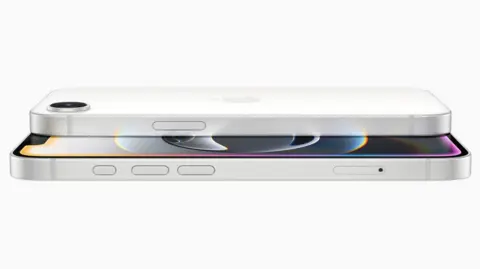Apple has recently unveiled its new budget-friendly smartphone, the iPhone 16e, which aims to integrate artificial intelligence (AI) features into a more accessible pricing structure compared to its flagship models. Positioned strategically to entice consumers, the iPhone 16e boasts the same powerful processor, the A18 chip, as seen in the more expensive iPhone 16. Despite sharing this advanced technology, the phone features lower specifications in certain areas, including a reduction in camera capabilities. This move reflects Apple’s ongoing struggle to revive interest in its products amid a noted decline in iPhone sales towards the end of the previous year.
The launch of the iPhone 16e appears to be part of Apple’s strategy to reignite consumer excitement by offering enhanced AI functionalities without the hefty price tag typically associated with its top-tier devices. While expectations are high, analysts maintain a degree of caution regarding the extent of sales growth that new AI capabilities are likely to yield. The announcement also draws attention to Apple’s historical context, as the name “iPhone 16e” harkens back to its earlier value-oriented line, the iPhone SE series, which provided budget options from 2016 until 2022.
Availability is another significant aspect of the iPhone 16e’s launch; pre-orders begin on February 21 across 59 countries, including a competitive price point in the UK set at £599. This pricing is notably £200 less than the standard iPhone 16. However, it is more than twice the initial launch price of the original iPhone SE in 2016. Industry analyst Paolo Pescatore emphasized the cost-effectiveness of the 16e, asserting that it could become one of the most affordable and powerful iPhones currently available, which could lead to an acceleration in consumer adoption, particularly among those interested in the emerging AI features.
Delving into the AI components, much of the attention surrounding the iPhone 16e will likely focus on its capabilities stemming from the same robust A18 chip utilized in its pricier counterparts. This design facilitates the 16e’s capability to run the same applications and games as other iPhones, by positioning AI as a central aspect of the overall value proposition. Tim Cook, Apple’s CEO, articulated during the announcement that the new device is engineered for “performance, intelligence, and privacy,” aligning with renewed consumer expectations for advanced functionalities.
The integrated AI functionality, referred to as Apple Intelligence, includes enhanced tools for writing and the incorporation of OpenAI’s ChatGPT into Siri, which expands the voice assistant’s functionality. However, Apple’s journey into AI has not been without challenges; past missteps have included the temporary suspension of AI-generated news alerts due to inaccuracies tied to prominent news organizations.
This iteration of Apple’s smartphone also emphasizes practical applications of AI, with capabilities designed to streamline tasks such as photo editing and searching through image libraries. While various other smartphone manufacturers have already begun offering similar features, the iPhone 16e stands out as the most budget-friendly entryway to AI within the Apple ecosystem.
The introduction of the iPhone 16e is expected to open up new revenue streams for Apple, particularly in key markets such as India, where price sensitivity has traditionally been a barrier to entry for many consumers. Additionally, the pricing of the 16e could attract new users to the Apple ecosystem, reducing the financial barriers for those looking to upgrade or switch from other platforms. As the company aims to capitalize on its reputation and the allure of its AI innovations, the iPhone 16e could play a crucial role in rekindling interest among consumers who have been hesitant to invest in Apple’s premium offerings.



